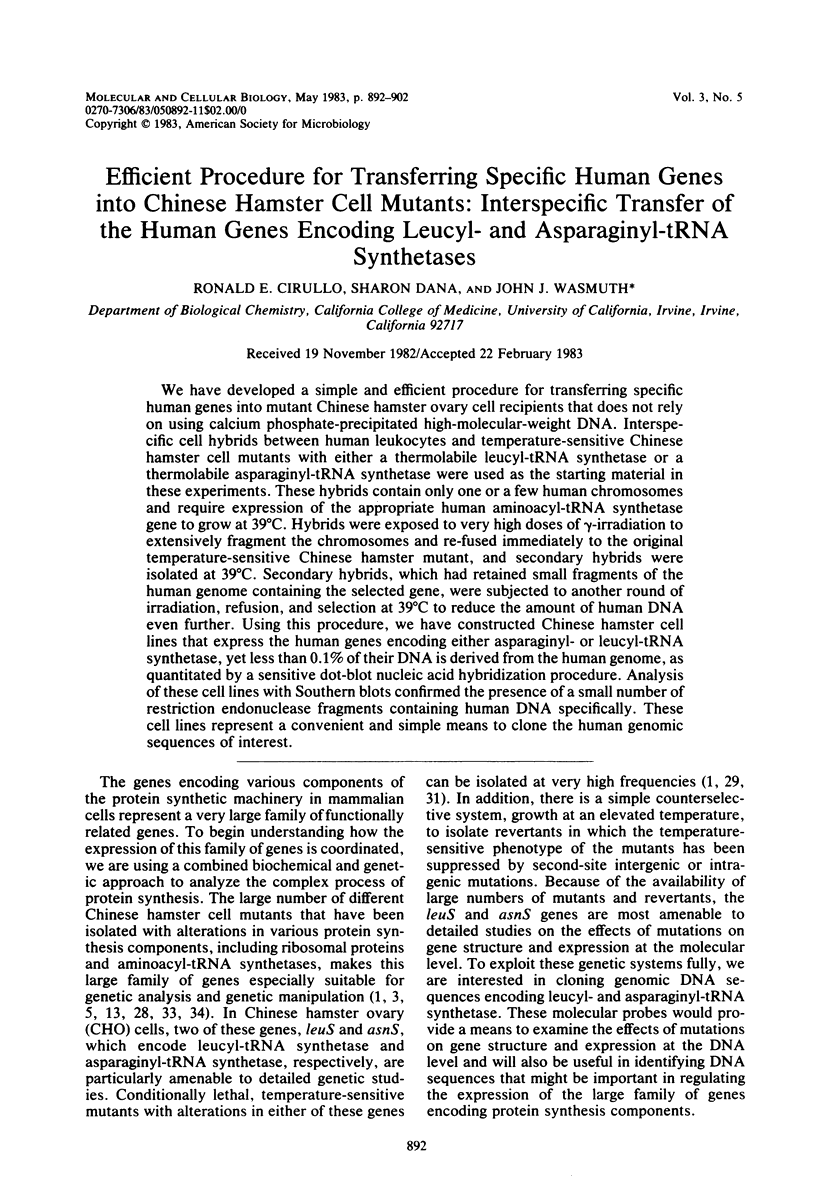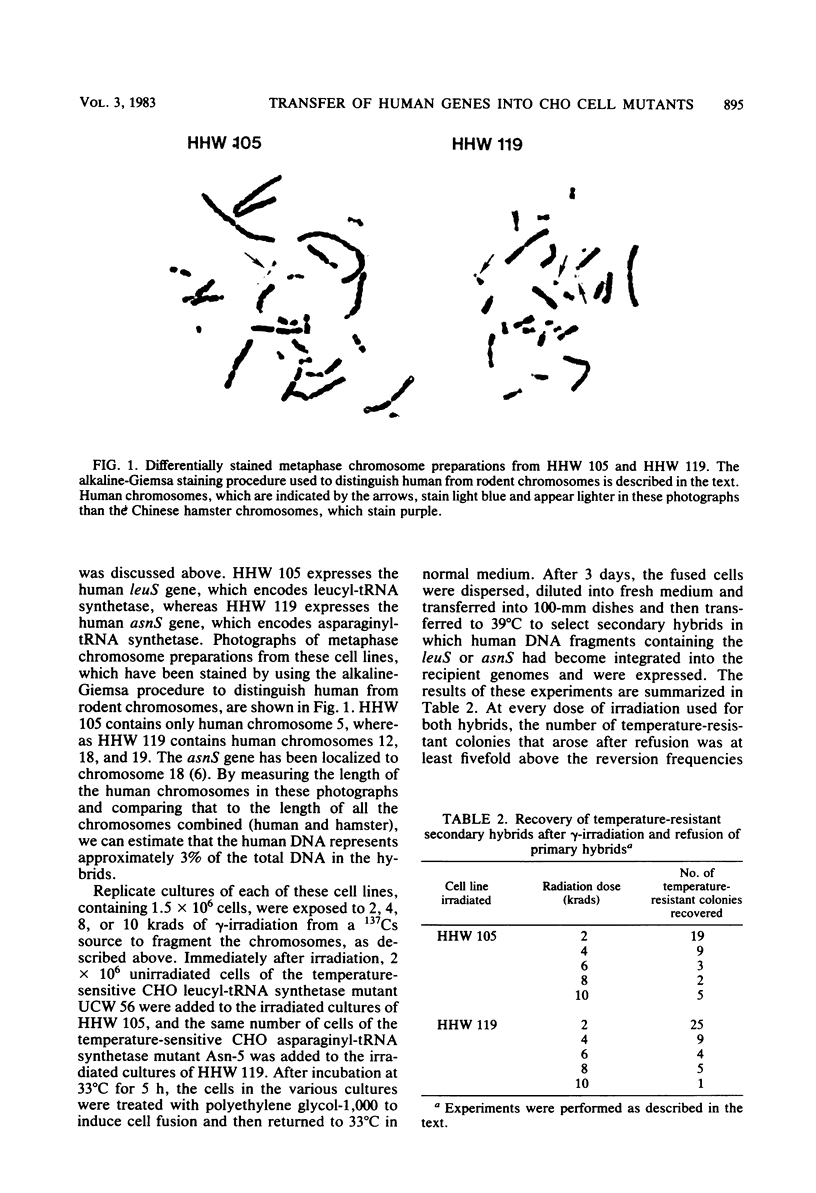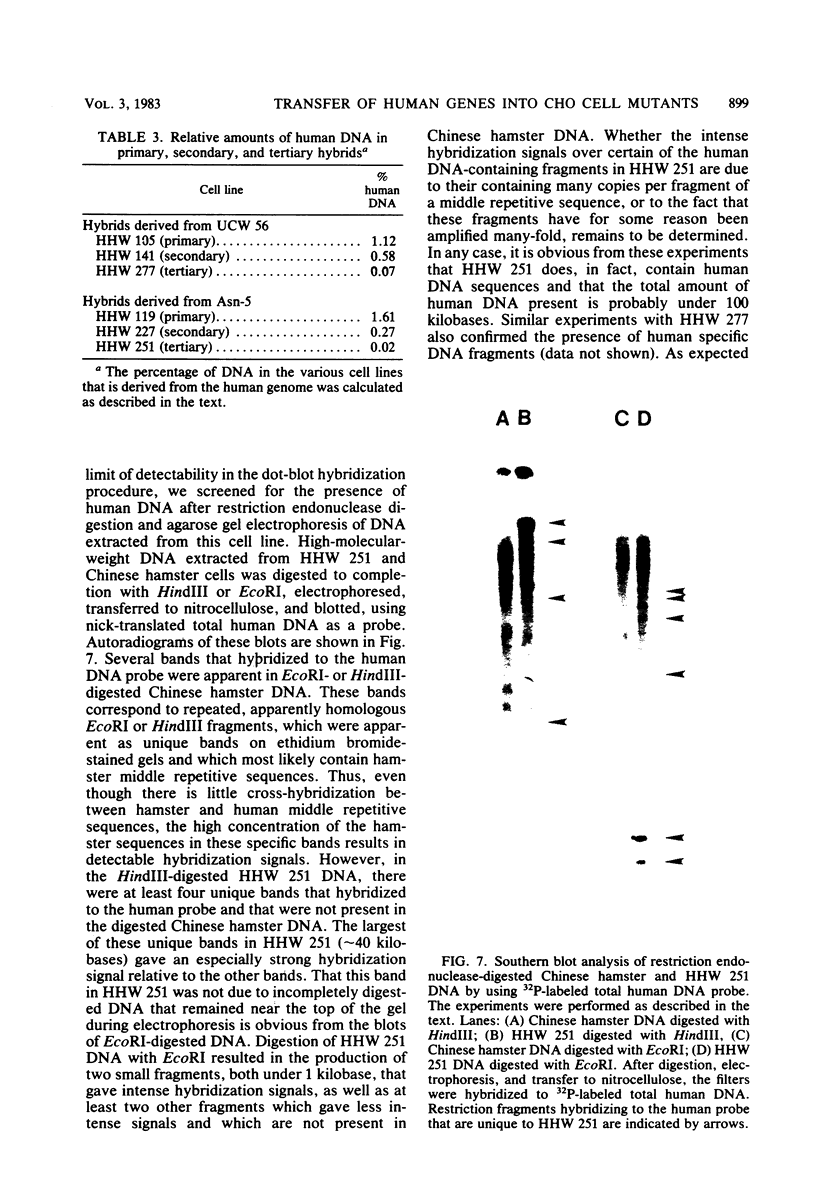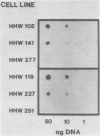Abstract
We have developed a simple and efficient procedure for transferring specific human genes into mutant Chinese hamster ovary cell recipients that does not rely on using calcium phosphate-precipitated high-molecular-weight DNA. Interspecific cell hybrids between human leukocytes and temperature-sensitive Chinese hamster cell mutants with either a thermolabile leucyl-tRNA synthetase or a thermolabile asparaginyl-tRNA synthetase were used as the starting material in these experiments. These hybrids contain only one or a few human chromosomes and require expression of the appropriate human aminoacyl-tRNA synthetase gene to grow at 39 degrees C. Hybrids were exposed to very high doses of gamma-irradiation to extensively fragment the chromosomes and re-fused immediately to the original temperature-sensitive Chinese hamster mutant, and secondary hybrids were isolated at 39 degrees C. Secondary hybrids, which had retained small fragments of the human genome containing the selected gene, were subjected to another round of irradiation, refusion, and selection at 39 degrees C to reduce the amount of human DNA even further. Using this procedure, we have constructed Chinese hamster cell lines that express the human genes encoding either asparaginyl- or leucyl-tRNA synthetase, yet less than 0.1% of their DNA is derived from the human genome, as quantitated by a sensitive dot-blot nucleic acid hybridization procedure. Analysis of these cell lines with Southern blots confirmed the presence of a small number of restriction endonuclease fragments containing human DNA specifically. These cell lines represent a convenient and simple means to clone the human genomic sequences of interest.
Full text
PDF










Images in this article
Selected References
These references are in PubMed. This may not be the complete list of references from this article.
- Andrulis I. L., Chiang C. S., Arfin S. M., Miner T. A., Hatfield G. W. Biochemical characterization of a mutant asparaginyl-tRNA synthetase from Chinese hamster ovary cells. J Biol Chem. 1978 Jan 10;253(1):58–62. [PubMed] [Google Scholar]
- Ashman C. R. Mutations in the structural genes of CHO cell histidyl-, valyl-, and leucyl-tRNA synthetases. Somatic Cell Genet. 1978 May;4(3):299–312. doi: 10.1007/BF01542844. [DOI] [PubMed] [Google Scholar]
- Benton W. D., Davis R. W. Screening lambdagt recombinant clones by hybridization to single plaques in situ. Science. 1977 Apr 8;196(4286):180–182. doi: 10.1126/science.322279. [DOI] [PubMed] [Google Scholar]
- Boersma D., McGill S., Mollenkamp J., Roufa D. J. Emetine resistance in Chinese hamster cells. Analysis of ribosomal proteins prepared from mutant cells. J Biol Chem. 1979 Jan 25;254(2):559–567. [PubMed] [Google Scholar]
- Cirullo R. E., Arredondo-Vega F. X., Smith M., Wasmuth J. J. Isolation and characterization of interspecific heat-resistant hybrids between a temperature-sensitive chinese hamster cell asparaginyl-tRNA synthetase mutant and normal human leukocytes: assignment of human asnS gene to chromosome 18. Somatic Cell Genet. 1983 Mar;9(2):215–233. doi: 10.1007/BF01543178. [DOI] [PubMed] [Google Scholar]
- Clarke L., Carbon J. A colony bank containing synthetic Col El hybrid plasmids representative of the entire E. coli genome. Cell. 1976 Sep;9(1):91–99. doi: 10.1016/0092-8674(76)90055-6. [DOI] [PubMed] [Google Scholar]
- Dana S., Wasmuth J. J. Linkage of the leuS, emtB, and chr genes on chromosome 5 in humans and expression of human genes encoding protein synthetic components in human--Chinese hamster hybrids. Somatic Cell Genet. 1982 Mar;8(2):245–264. doi: 10.1007/BF01538680. [DOI] [PubMed] [Google Scholar]
- Dana S., Wasmuth J. J. Selective linkage disruption in human-Chinese hamster cell hybrids: deletion mapping of the leuS, hexB, emtB, and chr genes on human chromosome 5. Mol Cell Biol. 1982 Oct;2(10):1220–1228. doi: 10.1128/mcb.2.10.1220. [DOI] [PMC free article] [PubMed] [Google Scholar]
- Friend K. K., Chen S., Ruddle F. H. Differential staining of interspecific chromosomes in somatic cell hybrids by alkaline Giemsa stain. Somatic Cell Genet. 1976 Mar;2(2):183–188. doi: 10.1007/BF01542631. [DOI] [PubMed] [Google Scholar]
- Goss S. J., Harris H. Gene transfer by means of cell fusion I. Statistical mapping of the human X-chromosome by analysis of radiation-induced gene segregation. J Cell Sci. 1977 Jun;25:17–37. doi: 10.1242/jcs.25.1.17. [DOI] [PubMed] [Google Scholar]
- Goss S. J., Harris H. Gene transfer by means of cell fusion. II. The mapping of 8 loci on human chromosome 1 by statistical analysis of gene assortment in somatic cell hybrids. J Cell Sci. 1977 Jun;25:39–57. doi: 10.1242/jcs.25.1.39. [DOI] [PubMed] [Google Scholar]
- Gupta R. S., Siminovitch L. The isolation and preliminary characterization of somatic cell mutants resistant to the protein synthesis inhibitor-emetine. Cell. 1976 Oct;9(2):213–219. doi: 10.1016/0092-8674(76)90112-4. [DOI] [PubMed] [Google Scholar]
- Gusella J. F., Keys C., VarsanyiBreiner A., Kao F. T., Jones C., Puck T. T., Housman D. Isolation and localization of DNA segments from specific human chromosomes. Proc Natl Acad Sci U S A. 1980 May;77(5):2829–2833. doi: 10.1073/pnas.77.5.2829. [DOI] [PMC free article] [PubMed] [Google Scholar]
- Gusella J., Varsanyi-Breiner A., Kao F. T., Jones C., Puck T. T., Keys C., Orkin S., Housman D. Precise localization of human beta-globin gene complex on chromosome 11. Proc Natl Acad Sci U S A. 1979 Oct;76(10):5239–5242. doi: 10.1073/pnas.76.10.5239. [DOI] [PMC free article] [PubMed] [Google Scholar]
- Jolly D. J., Esty A. C., Bernard H. U., Friedmann T. Isolation of a genomic clone partially encoding human hypoxanthine phosphoribosyltransferase. Proc Natl Acad Sci U S A. 1982 Aug;79(16):5038–5041. doi: 10.1073/pnas.79.16.5038. [DOI] [PMC free article] [PubMed] [Google Scholar]
- Kao F. T., Hartz J. A., Law M. L., Davidson J. N. Isolation and chromosomal localization of unique DNA sequences from a human genomic library. Proc Natl Acad Sci U S A. 1982 Feb;79(3):865–869. doi: 10.1073/pnas.79.3.865. [DOI] [PMC free article] [PubMed] [Google Scholar]
- Lowy I., Pellicer A., Jackson J. F., Sim G. K., Silverstein S., Axel R. Isolation of transforming DNA: cloning the hamster aprt gene. Cell. 1980 Dec;22(3):817–823. doi: 10.1016/0092-8674(80)90558-9. [DOI] [PubMed] [Google Scholar]
- Lund T., Grosveld F. G., Flavell R. A. Isolation of transforming DNA by cosmid rescue. Proc Natl Acad Sci U S A. 1982 Jan;79(2):520–524. doi: 10.1073/pnas.79.2.520. [DOI] [PMC free article] [PubMed] [Google Scholar]
- Maniatis T., Jeffrey A., Kleid D. G. Nucleotide sequence of the rightward operator of phage lambda. Proc Natl Acad Sci U S A. 1975 Mar;72(3):1184–1188. doi: 10.1073/pnas.72.3.1184. [DOI] [PMC free article] [PubMed] [Google Scholar]
- Pellicer A., Wigler M., Axel R., Silverstein S. The transfer and stable integration of the HSV thymidine kinase gene into mouse cells. Cell. 1978 May;14(1):133–141. doi: 10.1016/0092-8674(78)90308-2. [DOI] [PubMed] [Google Scholar]
- Rodgers A. Detection of small amounts of human DNA in human-rodent hybrids. J Cell Sci. 1979 Aug;38:391–403. doi: 10.1242/jcs.38.1.391. [DOI] [PubMed] [Google Scholar]
- Schmid C. W., Deininger P. L. Sequence organization of the human genome. Cell. 1975 Nov;6(3):345–358. doi: 10.1016/0092-8674(75)90184-1. [DOI] [PubMed] [Google Scholar]
- Shih C., Weinberg R. A. Isolation of a transforming sequence from a human bladder carcinoma cell line. Cell. 1982 May;29(1):161–169. doi: 10.1016/0092-8674(82)90100-3. [DOI] [PubMed] [Google Scholar]
- Southern E. M. Detection of specific sequences among DNA fragments separated by gel electrophoresis. J Mol Biol. 1975 Nov 5;98(3):503–517. doi: 10.1016/s0022-2836(75)80083-0. [DOI] [PubMed] [Google Scholar]
- Thomas P. S. Hybridization of denatured RNA and small DNA fragments transferred to nitrocellulose. Proc Natl Acad Sci U S A. 1980 Sep;77(9):5201–5205. doi: 10.1073/pnas.77.9.5201. [DOI] [PMC free article] [PubMed] [Google Scholar]
- Thompson L. H., Harkins J. L., Stanners C. P. A mammalian cell mutant with a temperature-sensitive leucyl-transfer RNA synthetase. Proc Natl Acad Sci U S A. 1973 Nov;70(11):3094–3098. doi: 10.1073/pnas.70.11.3094. [DOI] [PMC free article] [PubMed] [Google Scholar]
- Thompson L. H., Lofgren D. J., Adair G. M. CHO cell mutants for arginyl-, asparagyl-, glutaminyl-, histidyl- and methionyl-transfer RNA synthetases: identification and initial characterization. Cell. 1977 May;11(1):157–168. doi: 10.1016/0092-8674(77)90326-9. [DOI] [PubMed] [Google Scholar]
- Thompson L. H., Stanners C. P., Siminovitch L. Selection by [3H] amino acids of CHO-cell mutants with altered leucyl- and asparagyl-transfer RNA synthetases. Somatic Cell Genet. 1975 Apr;1(2):187–208. doi: 10.1007/BF01538547. [DOI] [PubMed] [Google Scholar]
- Wahl G. M., Stern M., Stark G. R. Efficient transfer of large DNA fragments from agarose gels to diazobenzyloxymethyl-paper and rapid hybridization by using dextran sulfate. Proc Natl Acad Sci U S A. 1979 Aug;76(8):3683–3687. doi: 10.1073/pnas.76.8.3683. [DOI] [PMC free article] [PubMed] [Google Scholar]
- Wasmuth J. J., Caskey C. T. Selection of temperature-sensitive CHL asparagyl-tRNA synthetase mutants using the toxic lysine analog, S-2-aminoethyl-L-cysteine. Cell. 1976 Dec;9(4 Pt 2):655–662. doi: 10.1016/0092-8674(76)90129-x. [DOI] [PubMed] [Google Scholar]
- Wasmuth J. J., Chu L. Y. Linkage in cultured Chinese hamster cells of two genes, emtB and leuS, involved in protein synthesis and isolation of cell lines with mutations in three linked genes. J Cell Biol. 1980 Dec;87(3 Pt 1):697–702. doi: 10.1083/jcb.87.3.697. [DOI] [PMC free article] [PubMed] [Google Scholar]
- Wasmuth J. J., Hill J. M., Vock L. S. Biochemical and genetic evidence for a new class of emetine-resistant Chinese hamster cells with alterations in the protein biosynthetic machinery. Somatic Cell Genet. 1980 Jul;6(4):495–516. doi: 10.1007/BF01539152. [DOI] [PubMed] [Google Scholar]
- Wasmuth J. J., Hill J. M., Vock L. S. Identification and characterization of a third complementation group of emetine-resistant Chinese hamster cell mutants. Mol Cell Biol. 1981 Jan;1(1):58–65. doi: 10.1128/mcb.1.1.58. [DOI] [PMC free article] [PubMed] [Google Scholar]
- Wigler M., Pellicer A., Silverstein S., Axel R. Biochemical transfer of single-copy eucaryotic genes using total cellular DNA as donor. Cell. 1978 Jul;14(3):725–731. doi: 10.1016/0092-8674(78)90254-4. [DOI] [PubMed] [Google Scholar]
- Wigler M., Silverstein S., Lee L. S., Pellicer A., Cheng Y. c., Axel R. Transfer of purified herpes virus thymidine kinase gene to cultured mouse cells. Cell. 1977 May;11(1):223–232. doi: 10.1016/0092-8674(77)90333-6. [DOI] [PubMed] [Google Scholar]







